
Doppelgänger – Claus Guth on Finding Inspiration in Park Avenue Armory, Jonas Kaufmann & Schubert’s ‘Genius’
By David SalazarIt’s late September in New York and a major European director is staging a unique new work at a historic venue.
And it stars Jonas Kaufmann, making his return to the Big Apple for the first time in two years.
Described by director Claus Guth as a “highly emotional trip” in a recent interview with OperaWire, “Doppelgänger” is gracing the Park Avenue Armory from Sept. 22 through the 28th.
The Journey to Doppelgänger
It centers on Schubert’s iconic “Schwanengesang” (among other works by the iconic composer) and came from a conversation that Guth had with Pierre Audi, the Artistic Director of the Armory.
“He kind of gave me a blank paper and told me to invent something for this venue,” Guth revealed. “And have Jonas Kaufmann at the center.”
The mere idea compelled Guth deeply, especially because he and Kaufmann studied in Munich together and had collaborated numerous times before.
But figuring out what that project would be proved to be a “very long journey.”
He visited the Armory to try and figure out what might work. Initially, his inclination was toward larger-scale works. “Mahler orchestras and songs or pieces from operas,” he noted.
But then…
“Somehow I thought that with this huge space the opposite would be interesting,” Guth narrated.”Something completely minimalistic and that’s completely focused on one lonely man standing there in this place.”
Schubert and his “genius” proved to be the key for a number of reasons. First off, per Guth, that very idea was at the core of most of Schubert’s famed song cycles.
And then there’s the fact that Kaufmann (alongside pianist Helmut Deutsch, also performing in this production) is one of the leading interpreters of the composer and Guth knew that he could not only get the most out of the tenor in this repertory, but that he would in turn receive a great deal as a director.
“Jonas always has a big intuition about what’s theatrically necessary to dig in and what’s too much so he always immediately finds that right kind of expression,” Guth emphasized. “And there aren’t many people in the world where I would dare to do a production like this, which is full of detailed directions.”
He noted that another of Kaufmann’s major assets as a collaborator is how quickly he learns and takes ownership of concepts.
“If you want to sketch something with him, he will remember immediately,” the German director noted. “And then it’s a nice collaboration because I give him a form and then he adds to it from his own experience. And he gives a deep soul to these Schubert songs. It’s fascinating to hear because he goes from the most incredible piani you ever heard, so soft, so delicate, and so fragile. And then in some songs, it suddenly sounds like Wagner. It’s so bold, dramatic, and big. So it’s amazing to work with an artist who has really this full range of possibilities.”

Credit: Monika Ritterhaus
An Army Hospital
Another artist who is instrumental to his work and was brought on for this project was set designer Michael Levine. The two have worked on productions of “Semele” and “Jenufa.” Both productions are marked by the intense black background that dominates over the proceedings. In “Jenufa,” this darkness is only ever contrasted by yellow leaves on the ground in one scene and cages in another. In “Semele,” a chandelier is at the center of the space with white as the other major contraster.
For “Doppelgänger,” the dark aesthetic continues with rows of beds dominating the stage as the two set the work in an army hospital.
“He’s really quite a genius of bringing things to the essence, to the really necessary thing that brings the thing alive. He goes into the depth of a theme,” Guth noted about Levine.
At the core of their conception was the second song in the cycle, “Kriegers Ahnung.”
“The premonition of a person being in war, of a soldier knowing that he will probably die. And then we came up with this idea of the installation,” Guth elaborated. “First we had an installation with only army suits, but then it changed into that the whole venue is filled with beds like in a field hospital.”
Joining Guth and Levine on the production team are costume designer Constance Hoffman, lighting designer Urs Schöenebaum, sound designer Mark Grey, video designer rocafilm, and movement director Sommer Ulrickson.
An Intense Journey
But the production isn’t simply setting a set of songs in an army hospital and calling it a day. An essential part of the experience is how the songs are staged and explored. Guth noted that, in his opinion, one of the great challenges of performing song cycles, especially longer ones by Schubert, is that after every song, you have to build up attention from song to song. Once a song ends, “people start coughing and then you’re back to zero again.”
So a storyline was essential in order to get rid of these interruptions and build an emotional flow.
“Schubert has this insane ability to just need four chords on the piano to create a world and atmosphere and with his wild harmonic changes, he directly grabs your heart,” he added. “In the ideal case, every time a Schubert song starts again, you’re kind of aware of the miracle of the music.”
He added that there will be other pieces to add interconnectivity to the action and narrative, including a sonata. The production also boasts 28 dances that will play a major role in building the story and Kaufmann’s character.
Finally, to further this immersion, the performance effectively kicks off 30 minutes prior to curtain with an installation to allow audience members to immerse themselves from the moment they arrive.
“It’s a journey through very different theatrical atmospheres. “People will be feeling like they are really in the middle of something,” Guth concluded. “It could be really intense, I think.”


